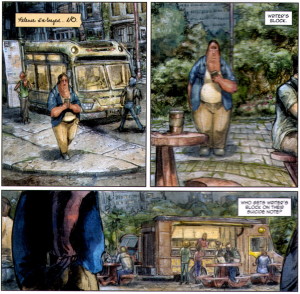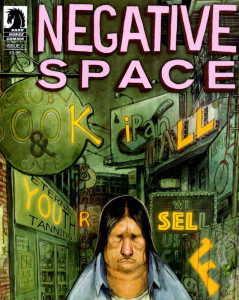Negative Space is a new limited series from Dark Horse comics and the creative team of Ryan K. Lindsay, the writer, and Owen GieniI, the illustrator.
Issue #1’s cover bears a Lovecraftian-type monster in the classic, menacing pose – open mouth equipped with rows of razor-sharp teeth; tentacles thrown akimbo and writhing to and fro; an unnatural, sicken hue to its hide – lurking in the ruins of a vast, ancient, and abandoned city.

Dark Horse’s billing is no less striking. Bearing the melodramatic lead-in “They feed on your fear”, the rest of the teaser reads:
When one man’s writer’s block gets in the way of his suicide note, he goes for a walk to clear his head and soon uncovers a century-old conspiracy dedicated to creating and mining the worst lows of human desperation.
– Dark Horse Comics
And just who is this one man whose writer’s block interferes with his goal of self-destruction? Our hero is a dumpy writer who is about as depressed as depressed can be. Down on his luck, Guy (yes, that’s his name) would end it all if only he could get past the ironic obstacle that prevents him from completing what should have been the easiest set of words he ever put down on paper. One wonders whether his already deep despair can fall even deeper as he realizes how impotent he is.

True to the advertising copy, Guy’s situation takes a turn into the bizarre when his walk brings him into direct contact with a resistance group seeking to free mankind from the forces that feed on human misery.
As the tale unfolds, Guy learns that the Lovecraftian monster emblazoned on the cover is a representative of a race of extraterrestrial beings who apparently feed off of human emotions. These ‘Evorah’ had invaded the Earth centuries (perhaps millennia) earlier and, after some period of time, had developed a working relationship with some of us to exploit all the others.

As Guy learns this dark history he also learns that he has some role to play in the quest to liberate mankind from the scourge of emotional slavery. After falling into orbit of resistance, this down-on-his-luck hero soon finds himself in the position to strike a blow for freedom.
My enthusiasm for this book was quite high when it was solicited but after reading the first two issues I was mildly disappointed. The writing was adequate but somewhat incoherent in places and the art was reasonably well-conceived and possessed a style that meshed well with the nature of the story. But what bothered me was that I couldn’t quite shake the feeling of been-there-done-that.
It took a while to pinpoint the origin of this feeling but when it finally clicked it was clear that despite superficial changes Negative Space is fundamentally a retelling of the classic 1988 John Carpenter film They Live.
They Live, which is set in Los Angeles, follows the down-on-his-luck character Nada played by Roddy Piper of pro wrestling fame. Nada has come to L.A. after having lost his job in a city in the interior of the country (possibly Detroit) and subsequently being abandoned, in short order, by his wife, his children, and society in general.
Nada manages to convince a construction foreman to let him work as a day laborer on a new building project. The work is hard and the foreman demanding but Nada holds out hope that he may be able to get on his feet again. Since the pay is meager, he stays in a transient community near the work site – a set of shacks, shanties, and hovels centered on a missionary church, which tries to feed and care for the hundreds of homeless who find themselves on the fringes of society, both geographically and politically.
After an arduous week of work, Nada finally has a day off and he begins to explore the church. Once he’s inside, he begins to get his first hint that the church may be more than a place of worship. His discoveries are cut short when the scores of police, sporting body armor and tear gas, move in on the settlement. During all the din and confusion, Nada slips through their fingers taking with him nothing more than an ordinary-looking pair of sunglasses from a supply that the church’s leaders were desperate to protect.
Wandering into the heart of the city, Nada soon discovers that the sunglasses reveal an inner-world of messages designed to keep the human cattle in line
Continuing to scratch beneath the surface, he soon discovers the truth – aliens have infiltrated society and subverted it to their goals. They and their human allies have the positions of power and luxury while the majority are kept in line with subliminal messages, economic manipulation, and, when necessary, naked force.
Nada soon goes from a down-on-his-luck loser to freedom fighter leading the resistance in throwing off the alien invaders and beating back their human collaborators. Sounds familiar, doesn’t it?
And so there you have it – Negative Space is They Live, with minor changes to disguise the obvious influence that the latter has on the former. Even the They Live ‘subliminal messages’ are evident in the front cover of Negative Space #2 where strategically darkened and illuminated letters from many signs spell out a sinister message for Guy.

Whether the subsequent execution of Negative Space will be strong enough to allow the series to stand on its own remains to be seen. I doubt it but I wish them luck.









